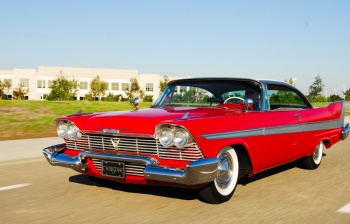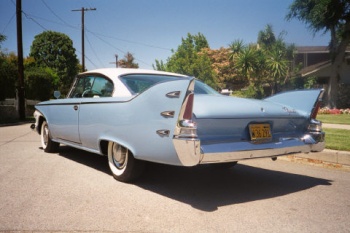Belvedere
Introduced on March 31, 1951, the 1951 Plymouth Belvedere arrived as a two-door pillarless hardtop. It was Plymouth's first vehicle of such design and was built in response to Chevrolet's Bel Air. The 1951 Belvedere was not a separate model - rather, it was the top-trim Cranbrook and being built on that car's 118.5 in wheelbase gave the two-door Belvedere favorable proportions. The Belvedere came in several body styles through the years and 1970 was the last year for the Belvedere name plate.
Contents
- 1 History:
- 2 Technical:
- 3 Year by Year Changes, Production Numbers, and Cost:
- 4 Wiki Topic References:
- 5 Magazine References:
- 6 External Links
History:
This Wiki is Under Construction, and can use your help!
Please take a moment to add any information you might have on this topic. It is through this type of Member collaboration that the MoparWiki will grow into being the Ultimate Mopar Infobase. The links contained in the Understanding Wikis box in the sidebar can help you get started.
Model Predecessor
Model Successor
The Satellite was the top of the line Belvedere in 1970 (the GTX was the top of the line performance model) but when the Belvedere name was dropped for 71, the Satellite name continued.
Export Versions
Related Models
Competition
Body Styles
Technical:
Class
- Mid-Priced Full Size through the 50s
- Mid-Priced Intermediate
Platform
Year by Year Changes, Production Numbers, and Cost:
1951
Engines
Transmissions
Length, width, height, wheelbase
1952
Engines
Transmissions
Length, width, height, wheelbase
1953
Engines
Transmissions
Length, width, height, wheelbase
1954
Engines
Transmissions
Length, width, height, wheelbase
1955
Engines
- 241 V8 (Dodge)
- 260 V8 (Dodge)
- 251 I6
Transmissions
- 3 speed manual
Length, width, height, wheelbase
1956
Engines
Transmissions
Length, width, height, wheelbase
1957
Engines
Transmissions
Length, width, height, wheelbase
1958
Engines
- 318 V8
- 350 V8 (Big block Dodge)
- 361 V8 (Big block Dodge)
Transmissions
- Torqueflite automatic
- 3 speed manual
Length, width, height, wheelbase
1959
Engines
- 318 V8
- 361 V8 (Big Block Dodge)
- 383 V8 (Big Block Dodge)
- 383 V8 (Big Block Chrysler)
Transmissions
- Torqueflite automatic
- 3 speed manual
Length, width, height, wheelbase
1960
Engines
Transmissions
Length, width, height, wheelbase
1961
Engines
Transmissions
Length, width, height, wheelbase
1962
Engines
Transmissions
Length, width, height, wheelbase
1963
Engines
Transmissions
Length, width, height, wheelbase
1964
Engines
Transmissions
Length, width, height, wheelbase
1965
Engines
Transmissions
Length, width, height, wheelbase
1966
Engines
Transmissions
Length, width, height, wheelbase
1967
Engines
Transmissions
Length, width, height, wheelbase
1968
Engines
Transmissions
Length, width, height, wheelbase
1969
Engines
Transmissions
Length, width, height, wheelbase
1970
Engines
Transmissions
Length, width, height, wheelbase
Wiki Topic References:
Magazine References:
External Links
Random Page | Longest Wikis | Oldest Wikis | Newest Images | Newest Wikis | List of Categories | List of Every Freakin Wiki
- Register to Edit
- It takes less than 5 minutes to request registration for editing, and we try to approve within 24 hours. Click the Register Link in the Top Bar.
- MoparWiki Help
- While editing Wikis may at first glance appear a little overwhelming, it really isn't. You will find this site's HELP (link found in the sidebar) to be very strong and easy to understand. The best way to start is with small edits and working on your user page -- and you will become a Pro in no time.



